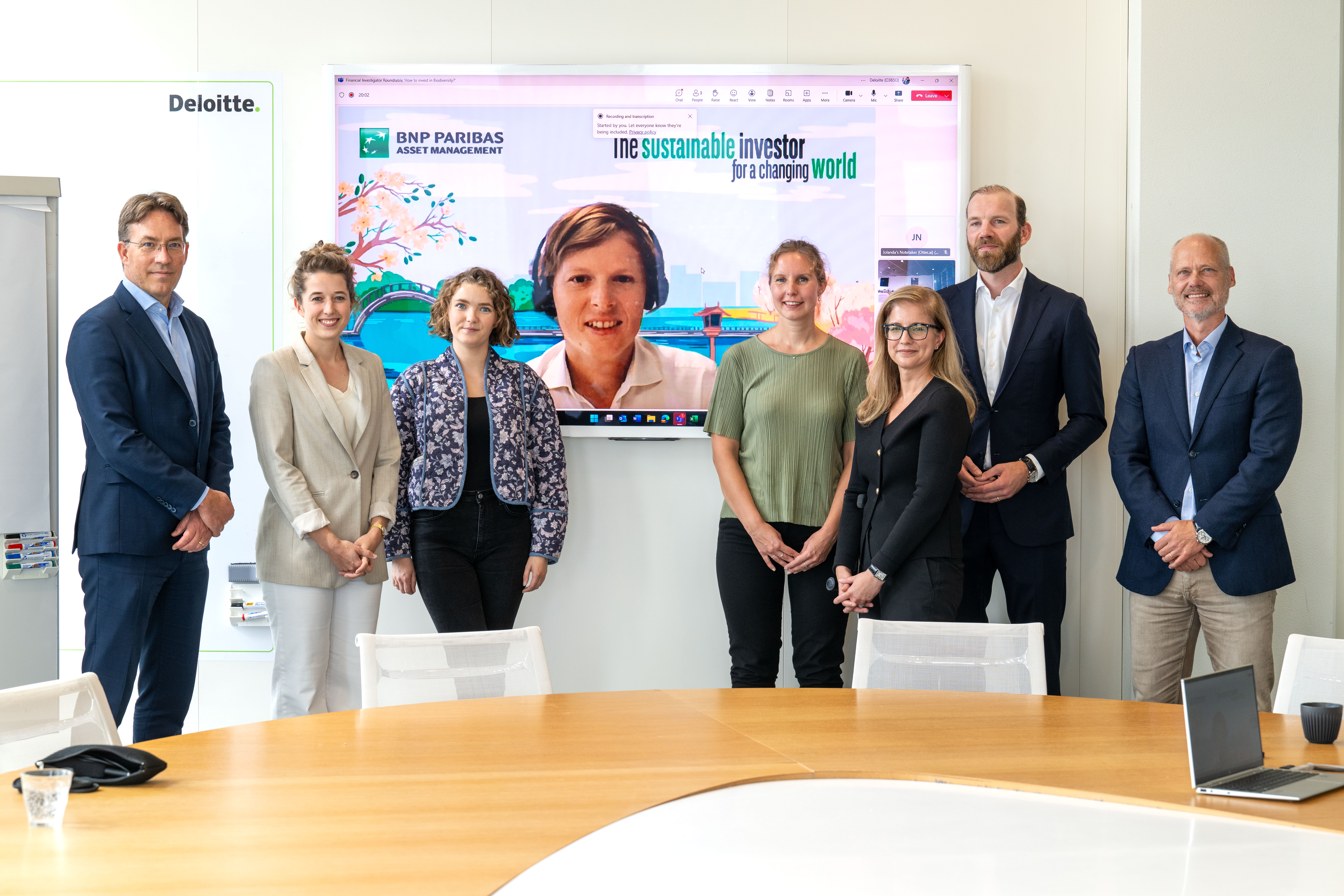From urgency to value creation (Round Table 'Biodiversity' – part 1)

This text was originally written in Dutch. This is an English translation.
Biodiversity is not only an ecological issue, but also an economic opportunity. Restoring ecosystems can create value, from agriculture and forestry to real estate and fixed-income impact instruments. In part 1 of our round table discussion, we discuss why investing in nature is particularly relevant right now and where the greatest opportunities lie.
By Hans Amesz
This is part 1 of the report. Part 2 will be published on Monday 10 November, part 3 on Thursday 13 November.
|
MODERATOR Don Gerritsen, Deloitte
PARTICIPANTS Jolien de Jongh, Achmea Real Estate Sophie Kamphuis, MN Sasha Miller, Nuveen Lucian Peppelenbos, Robeco Robert- Alexandre Poujade, BNP Paribas Asset Management Gerard Roelofs, Impact Orange Partners Nikki Trip, AF Advisors |
Does investing in biodiversity offer opportunities?
Robert-Alexandre Poujade: 'Absolutely. Precisely because there has been so much loss of biodiversity (according to the WWF, biodiversity has declined by more than 70% since the 1970s), restoring and returning to 100% healthy ecosystems offers a great investment opportunity. I am quite optimistic about the role of the financial sector in contributing to this and channelling our clients' money towards recovery.'
Lucian Peppelenbos: 'It offers an opportunity with a forward-looking perspective. The financial materiality is limited for the time being, but will increase in the long term. A sub-theme such as water is financially material in many sectors and regions, but a theme such as pesticides is less so. It depends on policy and progress in the real economy. In the longer term, investing in biodiversity is becoming increasingly material. The underlying science is not changing, so it is a future-oriented transition opportunity. Companies that are preparing for this transition can be an attractive investment. Many of our institutional clients have such a long-term perspective, so for us as an asset manager, it offers a commercial opportunity to work with them.'
Sasha Miller: 'We believe that there are investment opportunities today in areas such as nature-based solutions and the emergence of environmental markets. As a major natural capital investor in agricultural and forest land, we focus on five themes: biodiversity, soil health, climate mitigation and resilience, water, and communities. What often remains undervalued is the potential of fixed-income markets as a solution with high impact and scalability. We have developed and established new forms of financing: recently, for example, the Amazon reforestation bond, an outcome bond. There are also instruments such as blue bonds. These are opportunities to mobilise capital for concrete solutions and have been in operation for some time. The templates we create are now becoming more scalable: what used to take more than eighteen months to set up can now be done more quickly. With such templates, you can mobilise more capital to solve urgent issues, including biodiversity.'
Jolien de Jongh: 'For the short term, I am thinking of direct real estate investments. I see opportunities, particularly when it comes to the value of a building or area. It moves between risk reduction and investment opportunity. For example, you can create more shade, which improves the quality of life. This can generate higher rental income and increase the value of the property. The same applies to better water solutions. We need to be creative in linking this to existing real estate products.'
Gerard Roelofs: 'No one has yet proven that regenerative agriculture or sustainable forestry is less profitable than ‘traditional’ agriculture or forestry. So there is an opportunity there. Indirect impact – agritech, aqua tech – simply falls within venture capital and private equity: it may fail or succeed, but it does not necessarily have to underperform the broader universe. And as for new fixed-income instruments such as outcome bonds, green bonds and blue bonds, they do not have spreads that differ from government bonds. The “biodiversity market” has enormous potential, but it has yet to be recognised and explicitly linked to mitigating biodiversity loss or enabling solutions.'
Are the greatest opportunities in the short, medium or long term?
Roelofs: 'Society, regulators and we as investors have not yet arrived at a definitive set of KPIs and an unambiguous definition of biodiversity. As long as we continue to argue about this, it will take too long to measure properly. As a result, underlying investments are focused on the medium to long term rather than the short term.'
To get things done, it helps to set a good example. Just do it, start small, make it visible and share it with lots of people.
Sophie Kamphuis: 'The need for funding is certainly there in the short term. One of the goals for 2030 in the Global Biodiversity Framework is to mobilise at least two hundred billion dollars per year to finance biodiversity. This amount must be achieved in part through the use of impact investments, green bonds and instruments such as blended finance and biodiversity credits. It is important that institutional investors explore such instruments, especially if the ambition of pension funds – and participants – is to make more of an impact. In addition, opportunities linked to biodiversity risks should not be ignored. These opportunities already exist – think of precision agriculture – which reduces both the impact on biodiversity and dependence on environmental factors.'
Nikki Trip: 'There are already many possibilities on the risk and investment side. Even if policymakers take their time, we must take the risks seriously now because they are very real. We must make every effort to ensure that the opportunities are seized in the short term, to save what can be saved now and then preserve and protect it in the long term.'
Why are we not investing massively in solutions? What are the challenges in making biodiversity investable?
Peppelenbos: 'What has held us back in recent years is the enormous effort required to establish definitions, data and measurements. I am now convinced that we are leaving that behind us. Last year saw two important breakthroughs. Firstly, in the joint definition of the most important nature impacts per industry sector. This provides focus. And secondly, improved datasets with data at issuer level have become available. These two developments make nature measurable and controllable in investment portfolios.'
Poujade: 'It's all about credibility. Lean on best practices and standards, such as those of the Taskforce on Nature-related Financial Disclosures (TNFD), the Science Based Targets Network (SBTN), the Partnership for Biodiversity Accounting Financials ( PBAF, and so on, and build the most credible product for the asset class in question, given the specific data restrictions. I opt for the broadest possible definition, so that different types of clients – whether they invest in ETFs or private assets – can get on board, each with their own requirements. It must not only be “good” for biodiversity, but also for climate and social aspects. Governance must reflect that. There are always trade-offs; you weigh them up and make a decision.'
What has held us back in recent years is the enormous effort required to set up the definitions, data and measurements.
De Jongh: 'If you really want to make progress, you have to look at the full spectrum of your investments. That means examining the value chains of all the companies in which you invest. If, for example, the value chain of such a company involves the extensive use of chemicals that are discharged, waste or poor working conditions, then as an investor you are effectively perpetuating this. If the chain causes too much damage, you should not invest in it. So it's not just about promoting biodiversity through opportunities, but also through exclusion.'
Poujade: 'Asset managers have an exclusion policy for specific sectors and companies. We have published sector criteria (wood, pulp, palm oil, agriculture, oil and gas, mining, etc.) and also look at Global Compact violations in the environmental field. Take industrial fishing on the high seas, for example: if a company accounts for 100% of the fishing effort there, the risk of overfishing and human rights violations is high. You can exclude such a company. The same applies to mining and other sectors.'
|
Don Gerritsen Don Gerritsen is Director and EMEA Sustainable Investment Leader at Deloitte. Prior to this, he held various management positions at PRI, the UN and KPMG in the US, the UK, Kenya and the Netherlands. He is the author of Guidance to Inspirational Leadership and founder of the pro bono mentoring initiative Pay It Forward. Gerritsen holds an Executive MBA in Strategy and a Master's degree in Public Administration. |
|
Jolien de Jongh Jolien de Jongh has been working at Achmea Real Estate since 2019, and since 1 April 2023 as ESG Manager Real Estate and Manager Investment Solutions. In this role, she is responsible for policy, new initiatives and reporting in the field of ESG. Embodied carbon and biodiversity are among her priorities. |
|
Sophie Kamphuis Sophie Kamphuis is Senior Responsible Investment Advisor at MN, where she advises clients on strategy development and active shareholding in the field of biodiversity. Previously, she worked at impact investor Triple Jump on impact funds in the field of renewable energy and SME financing. Before that, she worked as a strategy consultant for local banks in Asia and Africa on themes such as inclusive financing, digitisation and sustainable agriculture. |
|
Sasha Miller Sasha Miller is Managing Director and Head of Responsible Investing Strategy at Nuveen, responsible for the RI platform, international activities and innovation to deepen client relationships. She chairs the RI SteerCo and oversees the Impact platform. Prior to this, she held senior positions at Schroders, most recently as Head of Client Propositions and Strategy. Miller holds an MBA from Oxford and a BA in International Relations from Johns Hopkins. |
|
Lucian Peppelenbos Lucian Peppelenbos is Head of Sustainable Investment Thought Leadership at Robeco. He oversees the frameworks for integrating sustainability into the investment process. This includes SDGs, social themes, climate change and biodiversity. Before joining Robeco, he worked at APG Asset Management. Peppelenbos began his career in 1999 and holds a PhD in Social Sciences from Wageningen University. |
|
Robert- Alexandre Poujade Robert-Alexandre Poujade joined BNP Paribas Asset Management's ESG research team in 2015 and leads thinking on biodiversity. He has collaborated with Capitals Coalition, UNEP-WCMC and Global Canopy, among others, and represents BNP Paribas in forums such as TNFD and PBAF. He obtained a Master's degree in Management, specialising in Finance, from ESCP Europe Business School in Paris in 2010. |
|
Gerard Roelofs Gerard Roelofs is an impact investor and co-founder of Impact Orange Partners. With over 30 years of experience in asset and fiduciary management, he has held board positions at Kempen and NN Investment Partners and was a partner at WTW. Previously, he held positions at Deutsche Asset Management, ABN AMRO and UBS. He is also active as a supervisor. |
|
Nikki Trip Nikki Trip is a Consultant and Sustainability Specialist at AF Advisors. She mainly advises pension funds and asset managers on sustainable investing. She is also chair of JIIP (Young People in Institutional Pensions), a speaker and an aspiring pension fund director. She is also active in the media as co-host of BNR Duurzaam and commentator on pension issues. |








